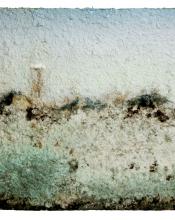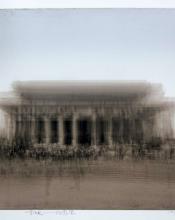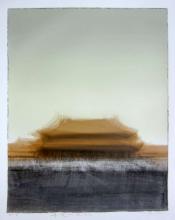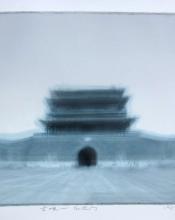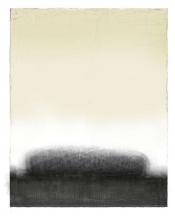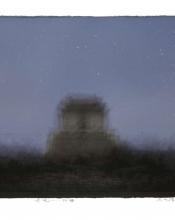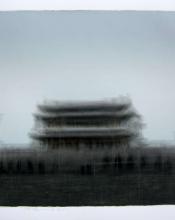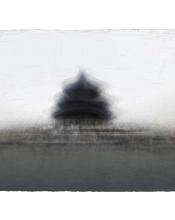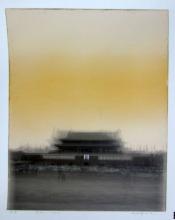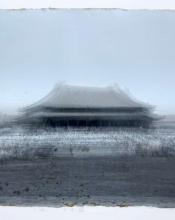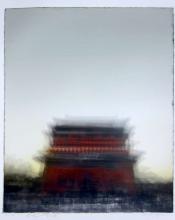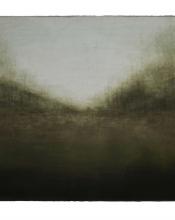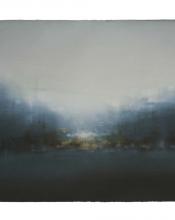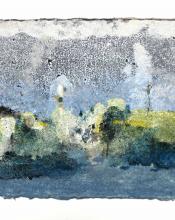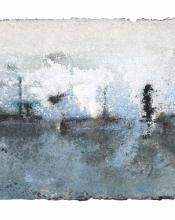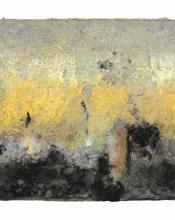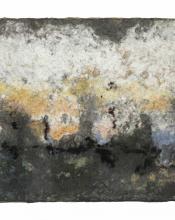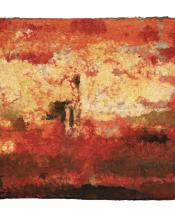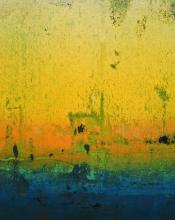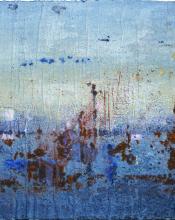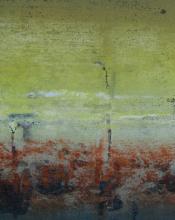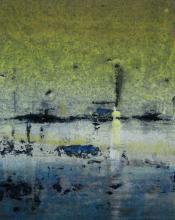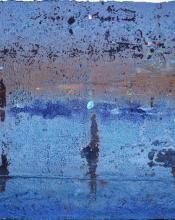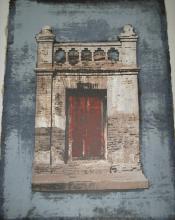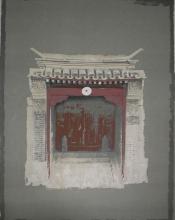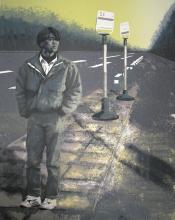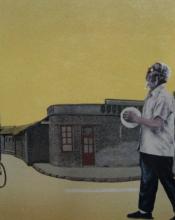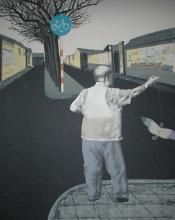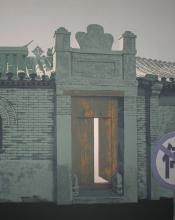Zhou Jirong
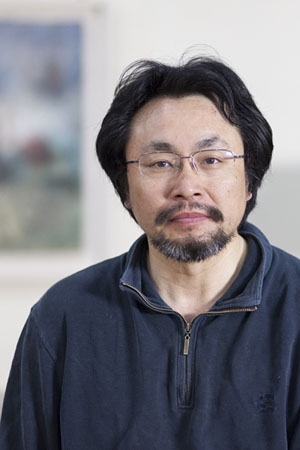
An Essay:Tally Beck
It follows logically that Zhou Jirong’s style has changed radically along with the city he has so keenly observed. His vision of Beijing is personal, even intimate at times. He invites us to understand the city through his eyes. His silkscreen prints of Beijing street life that he began producing in 1987 are formally clean and frank. Their mood is elegiac with a hint of wistful melancholy. Singular human figures linger in hutongs, quietly drinking in the charming atmosphere as if for the last time. Architectural elements, such as doorways and facades, are isolated as ruins and superimposed onto murky backgrounds, creating a surreal effect.
Formally, Zhou Jirong’s Beijing series bears little resemblance to his current work, but, upon careful consideration, his surface treatment forecasts his style in this series. His use of contrasting tones and textures lent the old walls and buildings a distinctive inner life. In his current work, we can see his rendering of this energy in a more painterly style. He has undergone a radical change from the rigorous technique of printmaking to his more expressive use of mixed media. This shift has further imbued his work with luminescence.
The dynamic nature of Beijing merits artistic witness, and Zhou Jirong proves his ability to deliver a personal and penetrating vision of urban transitions. In the essay in this catalogue, Zou Yuejin deftly underscores this artist’s deeper, philosophical relevance. As the Chinese capital transforms itself with effects we have yet to understand, Zhou Jirong’s testimony will provide a captivating record and help us ponder what has been lost and what has been gained.
October, 2008
The Illusory Nature of Existence: On the Meaning of Zhou Jirong’s Fantastic City Series: Zou Yuejin
In a way, Zhou Jirong’s Fantastic City series of recent years lend themselves to many interpretations, but I am most willing to approach them from the perspective of his unfailing attention to the artistic logic of China’s modern urbanisation.
I believe that in the works that make up Fantastic City, Zhou Jirong is clearly not offering realistic depictions of urban forms shrouded in darkness or bathed in fog. Rather, they hint at those beautiful forms in which truth and fiction become difficult to distinguish. He considers this unprecedented form of the modern metropolis from the perspective of philosophy and particularly metaphysics, and in so doing, his voices call into question the foundations of modern urban existence. As I see it, this thought process is double-edged.
Viewed directly, Zhou Jirong’s Fantastic City series depicts vistas of the modern metropolis, the contrasts that form between the bright sky and the dark city, demonstrating how the artist handles the entire formal and conceptual register of the modern city. However, as any urban-dweller can tell you, a city is not a single entity, and in fact can only exist in the imagination, as no one is able to grasp it in its entirety, let alone understand its true meaning. In other words, in relation to the modern city, we can only work as Zhou Jirong depicts, seeing the full range of its external appearance and then imagining its completeness and boundaries. We have no way of observing its interior, its full meaning and essence. Zhou Jirong uses his Fantastic City to represent directly the beauty of the modern city while exposing the existential dilemma of the urbanite: this intense visual interest is accompanied by emptiness and illusion.
The urban form that has gradually developed on the foundations of the Industrial Revolution is no doubt a transcendence and subversion of the principles of nature. Industrial production defies the logic of ‘work-by-day-and-rest-by-night,’ forming a cultural foundation for the modern city. Automobiles and transportation networks transform the city into a giant, artificial organism. The counterintuitive essence of the modern city is perhaps for Zhou Jirong the route to its emptiness and illusion. For this reason, just like a mirage, it can disappear in an instant. Zhou Jirong’s Fantastic City can thus be seen as a way of using beautiful form to portend human fate.
Before Fantastic City, Zhou Jirong focused his expressive powers on the Beijing courtyard house, creating a range of works on the subject of Old Beijing. In these works, Zhou Jirong depicts this nearly extinct cityscape and the leisurely lives of old Beijingers as a way of expressing nostalgia about traditional Beijing as a giant village and its imminent disappearance. Perhaps it is precisely this sentiment that makes Zhou Jirong able to confront directly the illusion of modern urban civilisation. From the perspective of art history, the first artists to address the metropolis were the Impressionist painters, full of romantic visual musings about its sunlight and dynamicism. A century later, Zhou Jirong continues to explore a romantic visual language, but as an artist, he no longer imagines the city as the pinnacle of human civilisation or as a springboard for an optimistic vision of the future. It seems that this is the true meaning carried by the mystical urban spaces in Zhou Jirong’s Fantastic City.
|
1962 |
Born in Xin’an, Guizhou |
|
1987 |
Graduated from the Printmaking Dept., Central Academy of Fine Arts (CAFA),Beijing |
|
Present: |
Professor, Deputy Head of Printmaking Dept., CAFA |
|
|
Supervisor of Doctoral, CAFA |
|
Solo Exhibitions |
|
|
2019 |
Cappella of the History, CAFA Art Museum |
|
2013 |
Uncertain Landscape – New Works, Red Gate Gallery |
|
2011 |
Twilight City – New Works On Paper, Red Gate Gallery |
|
2010 |
Zhou Jirong, Belgrade Serbia |
|
2009 |
Zhou Jirong, Cambridge, Britain |
|
2008 |
Fantastic City, Red Gate Gallery |
|
2006 |
Shadowland, Red Gate Gallery |
|
2004 |
Illusion, Red Gate Gallery |
|
2002 |
Mirage, Red Gate Gallery |
|
1998 |
Zhou Jirong - New Prints, Red Gate Gallery |
|
1997 |
Time·Space·Memory - New Prints by Zhou Jirong, Red Gate Gallery |
|
1996 |
Salamanca University, Salamanca, Spain |
|
|
Concha Marquez Gallery, Madrid |
|
1994 |
The City: Between the Old and the New, Red Gate Gallery |
|
1993 |
CAFA Gallery |
|
|
|
|
Group Exhibitions |
|
|
2019 |
Great Journey· Splendid View - Celebration of the 70th Anniversary of the Founding of the People's Republic of China, National Art Museum of China |
|
2018 |
Ab uno disce omnes - Chinese Printmaking Elites, Italian National Prints Center |
|
|
Print in the Post Print - 2nd CAA International Printmaking Triennial |
|
2017 |
Red Gate on the Move, Red Gate Gallery, Beijing |
|
|
4th Shanghai Printmaking International Biennial, China Art Museum, Shanghai |
|
2016 |
1st International Academic Printmaking Alliance Invitational, The Imperial Ancestral Temple Art Museum |
|
|
My Living Room – Red Gate 25th Anniversary, Red Gate Gallery |
|
2015 |
Art from Museums of China – Contemporary Chinese Printmaking and Sculpture Art, Harappa Contemporary Art Museum, Mexico |
|
2014 |
12th Printmaking Art, Guangdong Museum of Art, Guangzhou |
|
2013 |
National Project for the Creation of Fine Art Works on Major Historical Themes |
|
2012 |
Picturesque China·Developing Chinese Fine Art in the New Century, Shanghai Art Museum |
|
|
Two Generations - 20 Years of Chinese Contemporary Art Australian Tour: City of Sydney Chinese New Year; Manning Regional Gallery; Damien Minton Gallery; University of Newcastle Gallery; Melbourne International Fine Arts (MiFA); Linton & Kay, Perth |
|
2011 |
First International Print Triennial of ULUS, Belgrade, Serbia |
|
|
20 Years - Two Generations of Artists at Red Gate, island6 Art Center, Shanghai |
|
|
20 Years - Two Generations of Artists at Red Gate, Red Gate Gallery |
|
2010 |
Being Here - Audio and Visual Experience — Works from the China Printmaking Workshop Alliance 2010, Guan Shanyue Art Museum, Shenzhen |
|
2009 |
1st Contemporary China Engraving Academic Exhibition, Today Art Museum |
|
|
China Form, Red Gate Gallery |
|
2008 |
Silk and Sand – Contemporary Printworks of China and Australia, NSW |
|
|
Chinese Contemporary Printworks, Berlin, Germany |
|
|
2008 Art Olympic Games, Beijing |
|
|
Red Gate Stars, Red Gate Gallery |
|
|
Different Perspectives, Red Gate Gallery |
|
|
2nd International Printworks Tour, Beijing, Korea, Canada, USA |
|
2007 |
Seoul International Printworks Fair, Seoul Art Centre, Korea |
|
|
11th International Printmaking Biennial 2006, Canada |
|
2006 |
Red Gate Gallery’s 15th Anniversary |
|
|
Constructed Winds, Dashanzi International Art Festival, 798 / Beijing |
|
2003 |
1st Beijing International Art Biennale, National Art Gallery of China (NAGC) |
|
|
Beijing International Prints Biennale, Beijing |
|
|
Calendar of Contemporary Printmaking, Philip Hayden Foundation |
|
|
Fundraiser, Red Gate Gallery |
|
2002 |
Golden Harvest, Zagreb, Croatia |
|
|
Chinese Contemporary Art, Belgrade, Serbia |
|
|
West, North, East, South – China, Oslo, Beijing |
|
|
Square Studio, Guangdong Art Museum |
|
|
50 Chinese Contemporary Artists, Beijing |
|
2001 |
Square Studio, Shanghai Art Gallery |
|
|
Clues to the Future – Red Gate Gallery’s 10th Anniversary |
|
|
Eastern Wind, Norway |
|
|
Eastern Art, Norway |
|
|
China / Japan Prints Exchange, Japan |
|
2000 |
Macao International Prints, Macao |
|
|
Qingdao International Prints, Qingdao |
|
|
Square Studio, Shenzhen Art Museum |
|
|
Square Studio, Berlin |
|
|
See China Today Through Art, The Tree of Life, Qing Ping Gallery, Boston |
|
1998 |
Faces and Bodies of the Middle Kingdom, Galerie Otso, Espoo, Finland |
|
|
Retake: A Selection Reviewing Red Gate Artists’ Signature Works, Red |
|
|
Gate Gallery |
|
|
Square Studio, Beijing International Art Palace |
|
1997 |
Three Printmakers from CAFA, Red Gate Gallery |
|
|
Faces and Bodies of the Middle Kingdom, Galerie Rudolfinum, Prague, |
|
|
Czech Republic |
|
|
China’s Contemporary Printmaking, Portland Art Museum, USA |
|
|
Research of Asian Printmaking, Hokkaido, Japan |
|
|
Works Featured in the 1994 - 1998 BHP Calendars of Contemporary Chinese Art, Red Gate Gallery |
|
1996 |
Red Gate Gallery 5th Anniversary |
|
1995 |
Change – China Modern Art, Switzerland |
|
1994 |
New Art From China – Post '89, Marlborough Fine Art Gallery, London |
|
|
Sino – Japanese Art, Hiroshima, Japan |
|
|
8th National Works of Excellence, NAGC |
|
|
Red Gate Gallery, China Art Expo, Guangzhou |
|
1993 |
20th Century – China, NAGC |
|
|
Red Gate Gallery at China Art Expo, Guangzhou |
|
1991 |
I Don't Want to Play Cards with Cezanne, Asia Pacific Museum, California |
|
|
Beijing – Taipei, Modern Print, CAFA |
|
|
New Generation Art, NAGC |
|
1989 |
23rd International Contemporary Art, Monaco |
|
|
Young Mainland Printmakers, Taipei |
|
|
7th National Fine Arts, NAGC |
|
|
3rd Asian Art Biennial, Bangladesh |
|
1988 |
China Modern Art, New York Modern Art Expo, New York |
|
1987 |
Beijing Print Biennial, NAGC, Beijing |
|
|
|
|
Awards |
|
|
2002 |
Beijing International Prints Biennale, Excellence Award |
|
1999 |
Lu Xun Prints Prize |
|
1992 |
Beijing No. 8, Excellence Award, 20th Century - China |
|
1991 |
Beijing No. 1, Excellence Award, Beijing - Taipei Modern Print, Beijing |
|
1989 |
Beijing No. 3 and Beijing No. 4, Excellence Award, Young Mainland Printmakers, Taipei |
|
1987 |
Beijing No. 1, Excellence Award, Beijing Print Biennial |
|
|
|
The recent urbanisation in China has made cities like Beijing less particularly Chinese and more like any other international city - with all the associated environmental problems, upheavals of social order and overturning of traditional moral principles brought about by such progress. Driving around the ever-expanding city of Beijing, it is hard to recognise its unique characteristics. My relationship to the city has become blurry, hazy. It seems I have placed myself in a dream-world with no special features, no self, no sense of belonging … in a ficticious space....
Zhou Jirong

